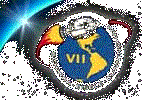|
The Apollo VII
Command Module
Comes Home to Texas
I was present on May 5, 2004, for the
installation of the historic Apollo 7 Command Module (CM 101) at
Dallas' Frontiers of Flight
Museum, where I have been a board member for many years. The
spacecraft, one of the premier exhibits at the Museum, is on loan from
the Smithsonian National Air and Space
Museum in Washington D.C.
My wife, Dot, and I worked to obtain
the Apollo 7 command module for the museum. I was enthusiastic about
returning the spacecraft to Texas, but it was Dot who persisted in a
three year campaign to get it released from a museum in Ontario, Canada. The museum staff
and a wonderful new facility convinced the Smithsonian Institution that
CM 101 would have a fine home in Dallas. Now, when I feel nostalgic, I
can just pop into the museum and reminisce about what the Apollo program
accomplished.
Apollo 7, the first manned flight of
the Apollo program, lifted off from Cape Kennedy on October 11, 1968,
carrying Wally Schirra, Donn Eisele and myself. This was the first
flight test of the redesigned command module after the fatal launch pad
fire of January 27, 1967. We performed all the critical tests of
spacecraft systems necessary for "wringing out" a new generation of
spacecraft. The mission's objective was to check the performance of the
crew, prime and backup spacecraft systems, and mission support
facilities. Following splashdown, the mission was described by NASA
management as a "101 percent success."
Apollo 7 is also known for the first
live television broadcasts from a American manned spacecraft.
The Museum's new 100,000-square-foot
facility is located at the Southeast corner of Dallas' Love Field. It
features a historic collection of airplanes, both civilian and military,
aircraft models, rare aviation artifacts, period photos and
memorabilia. For more information, visit
www.flightmuseum.com |

